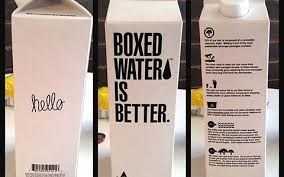Can Cartons Or Pouches Be Used For PET Water Bottles?
A boxed water company has been increasing its distribution and stand-up pouches are a fast-growing trend in food packaging, while PET bottles have become flimsier.
Is water packaging like milk carton-like boxes or for that matter stand-up pouches likely to pose a threat to PET bottles?
Michigan-based , the originator of the carton water packaging, has expanded its reach since its inception in 2009, to 14 states plus Canada and Australia, with 56 distributors and over 6000 stores in the U.S. It is also generating large revenue by supplying boxed water to music festivals such as Lollapalooza in Chicago. The company says it “recyclable” cartons are made of 76% renewable resource, and that the trees used to make their boxes come from certified, well-managed forests. It also ships its boxes flat to its filler which is significantly more efficient compared to shipping empty plastic or glass bottles.
I asked John Maddox, president ofconsultancy and a 34-year PET expert to give us his take. “I’ve drunk water from these containers (at an undisclosed paper container supplier). It is absolutely deplorable! The PE liner taste made it undrinkable…so, on taste alone, it will be a loser.” He also sees total life cycle a problem noting that mixed materials pose major hurdles on recycling and that, without recycling, the whole life cycle analysis falls apart. On a positive note, shipping and shelf cube are good and graphics are awesome, he says.
One my colleagues remarked that he dislikes gable-top cardboard “boxes”, noting how unpleasant they are to open and that they appear low-class compared with a PET bottle, especially the newer ones with a wide mouth and a giant cap. Personally, I doubt I would ever want to jog or go to the gym carrying boxed water though I might think of it as an option for my disaster preparedness kit.
Another colleague says he can see water going to stand-up pouches, noting, “With how flimsy PET bottles are now, we’re practically there.” Maddox concedes that stand-up pouches, which he says often don’t stand, are really hot right now. He says that for lunch boxes and hiking trips, they might be a good alternative but sees taste still being an issue, unless the inner layer is a PET coating.
He also emphasizes the attractive feature of resealability on a water bottle versus pouches which he says don’t deliver a very attractive resealable closure. “If they do, then the cost is up and then you have the option of a very flimsy PET bottle with a cap. In fact, I squeeze down my partially consumed PET water bottles. They do not roll away, they take up less space, and squeezing them helps dispense the contents. When empty, I squeeze them all the way flat, replace the cap so they stay that way and contribute to smaller volumes going into recycle bins, recycling transportation, or perhaps even a landfill. So, why make a ‘stand-up’ pouche for water? We already have them…a 9-gram PET bottle!”
Please don’t hesitate to let us know your take on this!

Related Content
-
Part 3: The World of Molding Thermosets
Thermosets were the prevalent material in the early history of plastics, but were soon overtaken by thermoplastics in injection molding applications.
-
How to Optimize Injection Molding of PHA and PHA/PLA Blends
Here are processing guidelines aimed at both getting the PHA resin into the process without degrading it, and reducing residence time at melt temperatures.
-
The Fantasy and Reality of Raw Material Shelf Life: Part 2
For the vast majority of thermoplastics, the stability of the materials can be stated in years, not months. But there are exceptions where shelf life can be a serious issue.







